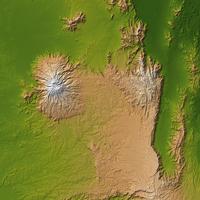Mbwebwe Peter- Warden incharde of Tourism Mt. Elgon National park Uganda from UGANDA writes:
Sasa Trail
The areas below 2000 metres are characterized by agricultural land dominated by coffee (Coffee Arabica) bananas, maize beans and human settlement. This area provides opportunity for agro-tourism. The ladders ascending to the Mudange cliffs on the Sasa tourist trail from Budadiri provide a commanding view of the greater part of Easter Uganda landscape. Mudange cliffs provides an enjoyable challenge to mountain climbers, reason as to why is popularly known as the “Wali of Death ladders”. Yet no visiter has ever died on that wall. Instead it gives thrilling experience to some visitors which become unique and an unforgettable moment. Tropical Montane Zone Montane forest, up to an elevation of 2500 metres, and it comprises 48% of the total park area, from 2000 – 2500metres is the high tropical montane forest rich with unique and endemic tree species such as Elgon teak Olea Wilswitchi. The 1996 Biodiversity report concluded that Mt. Elgon National Park is rich In biodiversity and it ranks in the top 10 (out of 65 Uganda’s forests) for trees and shrub. The report also concluded 296 bird species and 273 species of trees and shrubs now known from Mt. Elgon, 50 are uncommon and have been recorded in not more than five of the 65 forest reserves, 30 species of small mammals (bats. Shrews and rodents) and 5 species of primates as Baboons, blue monkeys, ververt monkeys, black and white colobus monkeys, red tailed monkeys.
Mixed bamboo zone
From 2500 -3000 metres is the mixed bamboo zone and low canopy Afromontane forest approximately occupying 21% of the park area. The mixed montane forest is made up of dense forest dominated by a range of species in a variety of combinations. The main species are Podocarpus moilanjianus and llex mitis, Other also found over a wide range but less frequently indude Dombeya goetzenii, Olea Africana and Xymolus monospora (Van Heist, 1994). Bamboo grows patchily on the southern and western slopes of Mt. Elgon maximum development of bamboo occurs at 2400 - 2700 metres, with quite extensive pure stands of up to 15 metres in height. Bamboo is not present on Mt. Elgon's northern slopes. Bamboo Rootstocks die out over large areas at intervals of 15 - 30 or more years. Regeneration from seeds takes place immediately.
Heath and moorland
The moorland located above 3500 metres constitutes 24% of the park area. The high montane heath and moorland tones are rich in shrub and herb species that are endemic olea welfwitschfi Elgon Teak , East African Olive wood Olea capensis, Brown Olive (wild olive} Oleo europoea, Hagenla abysslnfca Hagenia, Juniperus procera Pencil cedar, Alchemilla elgonensis ,Ladies Mantle, Lobelia elgonensis , Podocarpus gradlio, Juniper procera Juniper stands, Cosearia batiscombei, Cyothea Giant tree ferns, Philippic excels ,Giant heather, scencio elgonensis Giant groundsels, Cyperus atroalpinus Cyperus, Swertia subnivails. Physiographic features also have scenic and tourism values. Amongst the noteworthy physiographic features in this regard are the great cliff faces characteristic of Mt Elgon, the numerous waterfalls, the vast crater and crater rim, Dirigina Falls, Jackson’s pool Jackson’s summit, Wagagai peak, caldera, Mukutano Junction, Hot springs to handover point. The moraines, rock basin lakes and other glacial features of the upper mountain, the spectacular Suam Gorge, and the many and varied caves which are quite unusual in their number, variety, formation, and use by humans and animals, and are therefore particularly valuable from aesthetic and tourism perspectives.
Sipi trail
This route is 66km from Mbale town off Kapchorwa town. The trailhead is situated 7km from sipi Chema junction leading to Kapkwai Forest Exploration centre at Altitude 2050 m ASL Altltudlnally starts at 2050-2667 m asl. The mixed montane forest is made up of dense fort dominated by a range of species in a variety of combinations. The main species are Podocorp mailanjianus and remnants of Anigeria spp. Other species also found over a wide range but frequently include Ekerbergia capensis, Olea Africana and Neoboutania macro calyx {Van He 1994) Attractions enroute Include Chebonet falls, Kapkwai Cave, Wiri ridge View point, tropical montane forest mammals notably baboons, monkeys, water bucks, bushbucks, duikers, tree a rock hyrax, birding. The enormous Tutum cave is believed be connecting Uganda and Kenya (Tutum and Kitum) respectively. Altltudlnally ranges from 2667- 3383m ASL. Attractions here in include primates such as Black and white cofobus monkeys, flying mammals (fruit bats) inhabiting caves, scenic attractions notably Kajerl valley, spectacular ridges, Kajeri waterfalls.
Kajeri - Caldera - Mudde
This altitudinally extends from 3383 drastically raises to 4000asl within the calders rim and gradually drops to 3500m at mude cave camp. This zone is endowed with numerous attractions such as Kajeri valley, water falls, Sipi River, muyembe valley (3823), Mubiyi peak and rock sculptures, world cup shaped rock, high altitude plants notably scenecio, Lobelia elgonesis, forget me not, Ladles mantle, caldera, siyo cave, simu gorge, meandering stream from Nandukusl River, Hot springs. The caves shelter variety of animals like elephants, leopards, bats, and are unique tourist attractions especially for cave explorers and archeologists. Some caves have acted as source of salts such as sodium, calcium and magnesium, Buffalo, bush buck, water buck, giant forest hogs, monkeys, and baboons are all known to obtain salt from these caves (Weltzien, 1997).
Mude-wagagai
This zone altitudinally extends from 3500 m asi-4321.The attractions enroute to the summit and upper Dirigana falls, Animal species (Elephants, Civet cats, Buffaloes, jackals, bushbucks, duikers) Afro alpine plants within this zone Include the everlasting flowers, lobelia elgonensis, spine globes, heather species, endemic Juniper and olea species. Volcanic land forms such as craters, volcanic plugs, valleys (Sironko valley), Simu gorge, caldera and peaks notably Jackson peak (4165m asl) and the highest peak, Wagagaipeak at an elevation of 4321 m ASL.
2016-07-05 |









 Like us
Like us Follow us
Follow us Follow us
Follow us